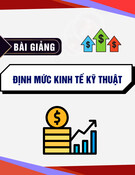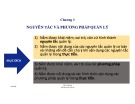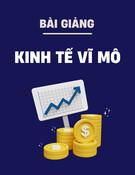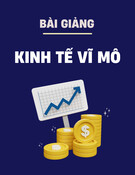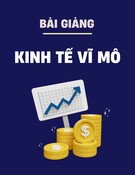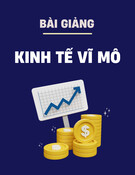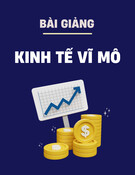
Homework 4
ESTIMATING AND FORECASTING DEMAND
SOLUTIONS
1 Demand generally becomes more elastic in the long run. Therefore, it is likely that demand
elasticity for business seats will increase. The price-raising proposal of the marketing
department is likely to face opposition from the business travelers and result in an
aggressive search for alternative forms of travel. Therefore, the five-year forecast is likely
to prove mistaken, and business travel will not grow very rapidly.
Some alternative means of travel for business, which will cut into revenue and profit
for the airline, include use of corporate planes (instead of commercial airlines) and
chartering planes for special occasions. For short trips, salespersons might well choose to
drive instead of fly. Businesses may also seek to negotiate lower fares by offering to buy
a number of seats in advance on a partially refundable basis.
Overall, you should conclude that total bookings may rise, but business bookings are
not likely to remain as profitable in the future as they have been in the past several years.
2 a. The college vice president’s equation contains at least some of the most
important variables that would affect demand: the tuition price and the income of
enrollees. However, it is also possible that other variables might be important,
such as tuition rates at rival institutions and financial aid practices.
b. Using the data provided:
Q = 5,400 - .2T + 1Y = 15,400 - (.2)(25,000) + (.1)(46,000) = 15,000 students.
Price elasticity = (dQ/dP)(P/Q) = (-.2)(25,000/15,000) = -.333.
No, the school is not maximizing profit, because tuition price and enrollment are
in the inelastic portion of the demand curve. The college should raise tuition.
3 a. We can transform the log specification to the normal form:
Q = 7.39P-1.25Y1.5S.67, after noting that antilog(2) = 7.39.
b. The forecasting equation is:
Q = 7.39P-1.25Y1.5S.67
Given P = $15, Y =102, and S = $12.50, it follows that Q = 1,400 units.
c. Yes, demand is somewhat elastic. Price elasticity is -1.25 (the power coefficient
associated with P in the multiplicative demand equation above).
4 a. The equation can be rewritten in logarithmic form:
Log(Q) = log(a) + blog(P) + clog(Y) + dlog(F).
b. The expected signs (based on economic theory) are:
P: Negative. An increase in price will lead to a drop in quantity demanded.
Y: Positive. Light trucks are normal goods.
F: Uncertain. If positive, this suggests that increased fuel prices lead drivers to
buy new (presumably more fuel-efficient) trucks. If negative, then high fuel

Managerial Economics – HSB
costs cause drivers to cut back their driving and (to an extent) their purchases
of new vehicles.
c. An R² of .49 is not very high under the circumstances. The adjusted R² is:
R² - [(k - 1) / (N – k)]·(l - R²) = .49 - [(4 - 1) / (10 – 4)]·(l - .49) = .235.
The F-statistic is: [R²/(k - 1)]/[(l - R²)/(N - k)] = [.49/(4 - 1)]/[(l - .49)/(10 - 4)] =
4.76. According to Table 4A. 1, significance at the 90% confidence level
requires F = 4.53. Therefore, one should not put too much trust or confidence in
this regression result.
5 In effect, omission of a variable is equivalent to the (perhaps implicit) assumption that
the coefficient for the variable is zero. Omission of variables that actually affect
demand tends to bias the estimated coefficients, which makes the results unreliable for
forecasting. The included independent variables are forced to “explain” more variation
in the dependent variable than they are able to do statistically.
A careful researcher should, therefore, include all of the important variables that
might affect demand. However, computation of adjusted R2 is important in informing
the researcher how much additional explanatory power a new variable brings to the
analysis. A small increase in adjusted R2 suggests that a new variable adds little or
nothing to understanding demand. Note that some variables may be mutually
correlated, or collinear. Collinear variables will bias the results toward
nonsignificance.
6 a. The log specification can be transformed into the multiplicative form:
Q = 7.39P-1.25Y1.5S.67,
after noting that antilog(2) = 7.39.
b. For the next four quarters, we have: Y1 = 103.0, Y2 = 104.05, Y3 = 105.1,
Y4 = 106.14 (1% quarterly growth) and, S1 = 12.75, S2 = 13.0, S3 = 13.265,
S4 = 13.53 (2% quarterly growth).
Substituting these values into the forecast equation (and including the unchanged
price, P = $15) implies: Q1 = 1,440, Q2 = 1,482, Q3 = 1,525, and Q4 = 1,568.
c. Sensitivity analysis seeks to determine the sales effect of changes in key
explanatory variables. Because regional income carries a sizeable coefficient
(1.5), an error in forecasting income growth will have a large impact on the sales
forecast. In addition, the competitor’s price is assumed to grow by 2% per
quarter, which makes it increasingly important in determining the firm’s sales.
An error here also will have a large effect on the forecast.


